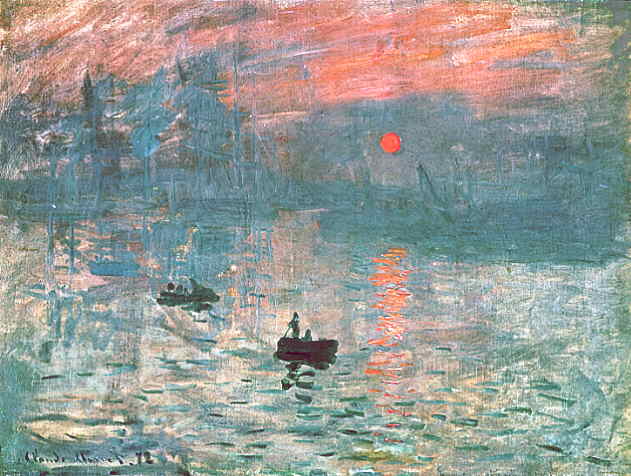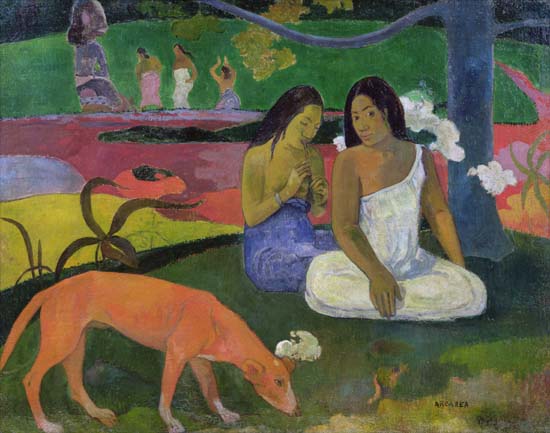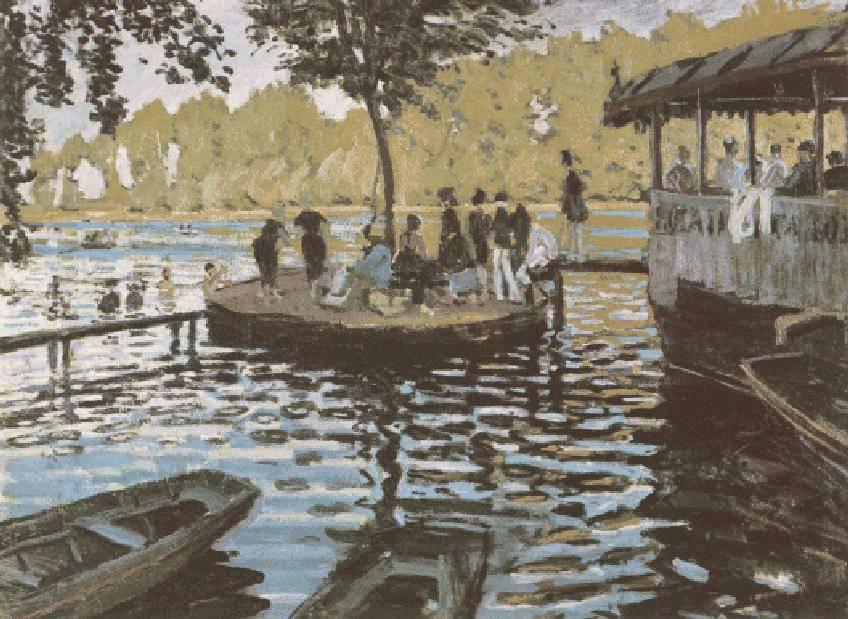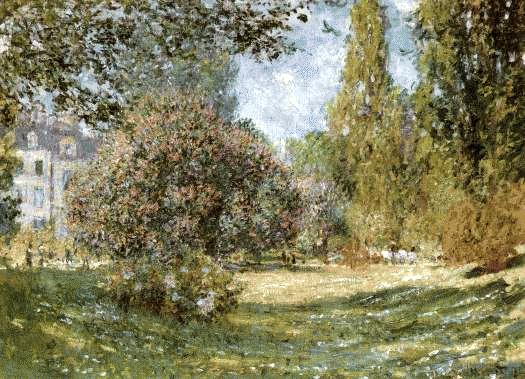
Posted on 06/01/2005 4:08:07 PM PDT by Republicanprofessor
I had such fun with my first Art Appreciation "class" last week. Thanks for all your support. For this second “class,” I’d like to discuss the basic ideas behind Impressionism and Post-Impressionism. Please continue to post more images that appeal to you; it’s great to have a continuing dialogue.
Let’s look at Impression: Sunrise by Claude Monet (1840-1926). This was done in 1874, and when it was exhibited, the slurred comments by a critic about it being only “an impression” gave the name Impressionism to the movement. Nowadays, however, we appreciate how it moves away from detailed realism to give us a different feeling of the moment. What is the weather, location, probable season? These were the concerns of the Impressionists. What kind of weather makes the sun so red at sunrise?

Later in the 1890s, Monet began several splendid series of works of similar subjects caught at different times of day: morning, noon, evening. He did these with grainstacks (or haystacks), Rouen Cathedral and poplar trees. Some complain that these works were just about light, color and atmosphere. (Cezanne is reputed to have said “Monet is just an eye, but what an eye!"). However, one article I read noted that these subjects are essential in French history and identity: the poplars are a national symbol, the grainstacks look like farmer’s thatched huts and thus glorify agriculture and farmers. Finally, the cathedrals are resonant with French gothic glory, since gothic cathedrals were initiated in France in 1144.
You can often guess the time of day in Monet’s Cathedral pieces because the entrance of these churches (in Europe) is always on the west side. Thus the light in the left image is clearly in the early morning. If you look on line, you can see different images from other times of day.
Monet’s latest Waterlilies series from the 1910s-1926 were awesome, but I’ll get to those later.
Another complaint of Monet was that his work was “formless:” that he had no hard edges, traditional space nor modeling (or shading). The Post-Impressionists like Paul Gauguin (1848-1903) added stronger forms, shapes and edges to the color of the Impressionists.

Gauguin’s Vision after the Sermon 1888. Done about the same time as Monet’s works, but notice how much more solid are the shapes (more fancily called forms). There is a sense of solidity and mass (or weight) about them.
A question I always ask my students about this work: is the space flat or is it deep? This is a very important question in modern art. The small cow in the upper left shows a sense of distance, especially from the huge (Sally Field Flying Nun-type) nuns’ hats. But the diagonal and red background really flatten the space. That diagonal, the cut-off forms, aerial perspective and non-heroic, daily subject are strong influences from Japanese prints, which were inundating France after Admiral Perry opened Japan 1853.

What’s happening in Gauguin’s work is that these Breton women of northern France have come out from church and are visualizing a reenactment of their sermon: Jacob wrestling with the angel. (My problem with Gauguin is that he often doesn’t touch my heart, as Monet does. One writer, I believe it was Rosenblum, said that Gauguin watches others worship, but we don’t feel him worshiping. That’s true of his later Tahiti works as well.)

Gauguin’s Day of the Gods from his later Tahitian period. I love the abstracted, colorful swirls of the water. Here even the water is solid. Note the Tahitian god in the background.
Now, here’s my toughest concept of the “class.” That flattened space of Gauguin, the flat space that also hints at a deeper space, is an essential theme of modern art. Renaissance perspective is old-fashioned, and after the invention of the camera, artists are trying to explore different kinds of space. Now, if you can see a movement back and forth between two and three dimensions, that creates a new kind of energy in painting. And, to me, this is a spiritual energy that affects my eyes, my body and my soul. Modern art can be seen as very spiritual, for it does affect the spirit and soul in a new way. This is not the traditional kind of Christian images seen in the past.
I have given short shrift to so many other Impressionists: Renoir, who preferred people (while Monet preferred landscapes); Degas, whose melancholy pervaded even his now-famous ballerinas; Mary Cassatt who updated the traditional Mother and Child icon to middle-and upper-class mothers and their children.


In the next “class,” in about a week or so, I want to compare and contrast the emotional works of van Gogh vs. the more controlled (but equally influential) works of Cezanne.
BTW, the latest thread by Liz on Klimt falls into this time-line of the Art Nouveau of the late 1890s. Symbolists like Klimt were a subcategory of the Post-Impressionists.
-%5BAIC%5D.jpg)
This Monet (I think it's the right one) is in the Getty, in L.A. When I was there, my niece couldn't understand what all the hubbub was about, so I told her to go over and look closely at the "white" snow. Only then did she realize that there wasn't any white, but dabs of grey, blue and pink.

witch=which
Henri was a bit later and more of an Ashcan artist (or predecessor thereof). His works tend to be darker, although their subject was revolutionary. I like the sunset in that work you posted.
Twachtman is wonderful, an American Impressionist but more original (I think) than Hassam or others. I love his Emerald Pool from Yellowstone.

Yes, Caillebotte is wonderful. I love the floor piece. I was unaware of the self-portrait or much of his history. He can slip through the cracks unless you make an effort to seek him out.
Ooops. I guess that Sally Field image just won't get out of my head, flying around in that early TV series.
You are absolutely right about the nuns; thanks for a great picture of their traditional costumes.
Thank you for the 2nd art appreciation class RProf. Can't keep my eyes off that first Monet you posted. Beautiful.
I love that Monet; it's one of my favorites. I can see him outside painting the other seasons of the haystacks, but it's hard to see him painting in the snow. It's COLD outside then. So this must have been a studio work, at least in part. The sunset and the blues and purples are awesome.
Is it a Renoir bar scene? (wild, undereducated guess.)
One of Monet's early influences was the "floating world" of Japanese art of the time. Was fortunate to see many of his paintings up close (or at large, rather), while visiting Chicago sometime back. I recommend it if you're ever in the area.
An aside: Monet is one reason the French will always have my undying enmity. I wanted to visit the Monet museum - the local townfolk (including a gendarme) kept giving me wrong directions. Thus, I got there late - about an hour left 'til closing. They wouldn't admit me "You would not have time to appreciate". I swore never to visit Paris again.
Monet it the Barry Manilow of Impressionism. You missed little.
The first one you posted of the seascape at sunrise, is a little *too* impressionistic for my taste; the boats & the water are fine, but the stuff beyond is kind of a mess -- I can't tell if the slate-colored crap at the upper left is supposed to be sailing ships, or a shoreline with mountains or buildings, or what.
But I like much of Monet's other work. I found an early one where he does a remarkable job on the water, given how little detail there is:

I don't much care for Gauguin stuff, though. The 'Vision after the Sermon' looks childish. Looks just as bad squinting at it.
I think the cow was probably just looking for a nice painting with a lush meadow and some reasonable sense of perspective (like the Monet below), but took a wrong turn at Albuquerque and ended up in Crazy Red Flatworld.

I guess I'm wrongheaded or just bullheaded - I like to look at the overlooked artists. There are a lot of good ones out there!

Really demonstrates the difference between French light and English light -- but they're going to the same place.
And of course there was the one that led to the famous libel suit against Ruskin for his comment "a pot of paint thrown in the public's face".


Painting water is difficult. I think it was Sir Kenneth Clark who noted that the impression of water was essential to Impressionism. Think of it: if the water is not still, how on earth do you pin it down to paint it? A wave or ripple comes towards you, and it's gone before you can comprehend its shape and color. Thus you study how water works and paint an impression of it.
Monet's late waterlilies are incredible, especially at the Carnegie in Pittsburgh. There is no horizon line. What you see is reflections from a millileter of water, and the reflections of sky, clouds and willows are infinite. Plus he is doing this at what I think of as sunset, at the sunset in his life. More profound than you might otherwise think.

This one is from Paris, not Pittsburgh. I couldn't sort thorugh over 2,000 images to find the Pittsburgh piece.
And Chicago does have great Monets and Impressionist works in general (including a fine Caillebotte).

Ping me.
Ping me.
Gonna take a rope and ping me.
From the branches of the highest treeeeeeeeeeeeee eee!
Woman, don't you weep for me!
Yes sir add me to the list, thanks.
Thanks for the ping!
Excellent
Disclaimer: Opinions posted on Free Republic are those of the individual posters and do not necessarily represent the opinion of Free Republic or its management. All materials posted herein are protected by copyright law and the exemption for fair use of copyrighted works.